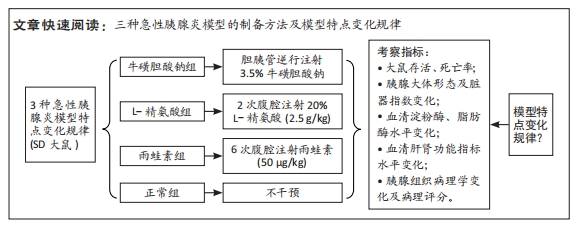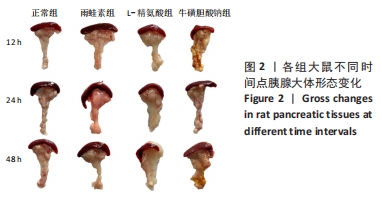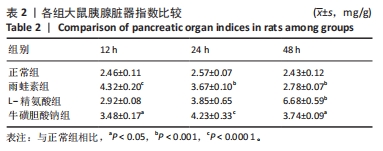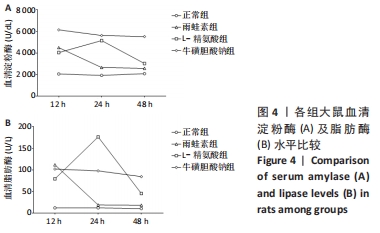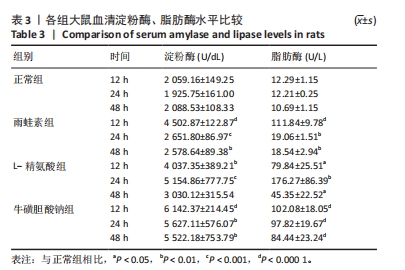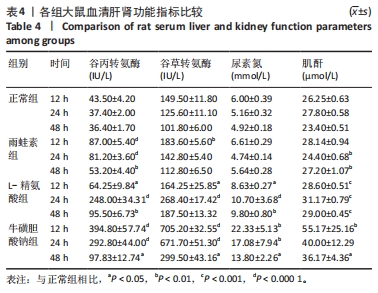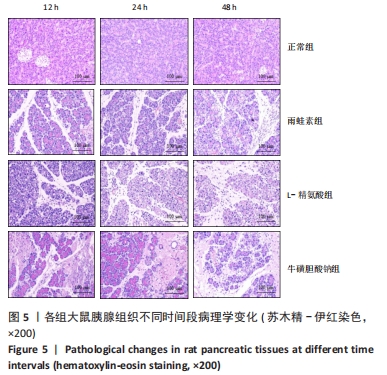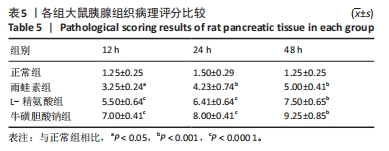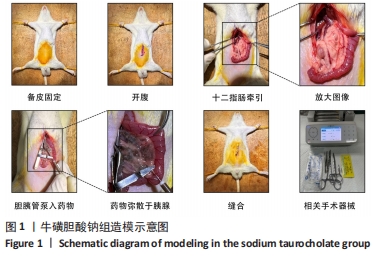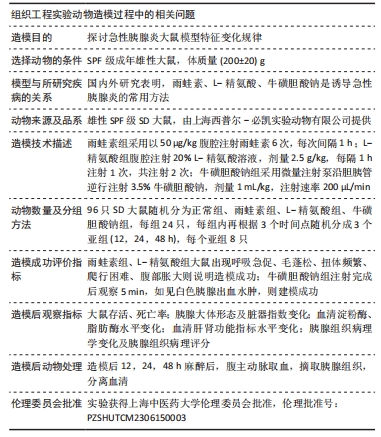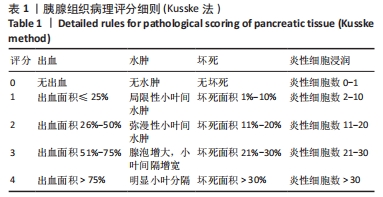[1] SONG Y, ZHANG Z, YU Z, et al. Wip1 Aggravates the Cerulein-Induced Cell Autophagy and Inflammatory Injury by Targeting STING/TBK1/IRF3 in Acute Pancreatitis. Inflammation. 2021;44(3):1175-1183.
[2] DING SP, LI JC, JIN C. A mouse model of severe acute pancreatitis induced with caerulein and lipopolysaccharide. World J Gastroenterol. 2003;9(3): 584-589.
[3] 杜奕奇, 陈其奎, 李宏宇, 等. 中国急性胰腺炎诊治指南(2019年,沈阳)[J]. 临床肝胆病杂志,2019,35(12):2706-2711.
[4] XIAO AY, TAN ML, WU LM, et al. Global incidence and mortality of pancreatic diseases: a systematic review, meta-analysis, and meta-regression of population-based cohort studies. Lancet Gastroenterol. 2016;1(1):45-55.
[5] BOXHOORN L, VOERMANS RP, BOUWENSE SA, et al. Acute pancreatitis. Lancet. 2020;396(10252):726-734.
[6] HE L, WANG L, HOU H. Bicarbonated Ringer’s solution improves L-arg-induced acute pancreatitis in rats via the NF-κB and Nrf2 pathways. Scand J Gastroenterol. 2023;58(3):276-285.
[7] ZHANG L, SHI J, DU D, et al. Ketogenesis acts as an endogenous protective programme to restrain inflammatory macrophage activation during acute pancreatitis. EBioMedicine. 2022;78:103959.
[8] LIU X, LUO W, CHEN J, et al. USP25 Deficiency Exacerbates Acute Pancreatitis via Up-Regulating TBK1-NF-κB Signaling in Macrophages. Cell Mol Gastroenterol Hepatol. 2022;14(5):1103-1122.
[9] 李涛,王海燕,刘丽玲,等. 大鼠实验性急性胰腺炎动物模型的建立[J]. 中国比较医学杂志,2003,13(6):358-361.
[10] LIN R, LI M, LUO M, et al. Correction to: Mesenchymal stem cells decrease blood-brain barrier permeability in rats with severe acute pancreatitis. Cell Mol Biol Lett. 2019;24:56.
[11] LEE PJ, PAPACHRISTOU GI. New insights into acute pancreatitis. Nat Rev Gastroenterol Hepatol. 2019;16(8):479-496.
[12] NEPOMNYASHCHIKH LM, LUSHNIKOVA EL, VISKUNOV VG, et al. Ultrastructure of acinar cell injuries in experimental acute pancreatitis created by common bile duct ligation. Bull Exp Biol Med. 2011;150(6):747-752.
[13] JAWOREK J, SZKLARCZYK J, KOT M, et al. Chemerin alleviates acute pancreatitis in the rat thorough modulation of NF-κB signal. Pancreatology. 2019;19(3):401-408.
[14] ABDELZAHER WY, AHMED SM, WELSON NN, et al. Vinpocetine ameliorates L-arginine induced acute pancreatitis via Sirt1/Nrf2/TNF pathway and inhibition of oxidative stress, inflammation, and apoptosis. Biomed Pharmacother. 2021;133:110976.
[15] 杨丹, 孙银凤, 白敏, 等. 基于PI3K/AKT信号通路的大黄牡丹汤对急性胰腺炎大鼠肺组织细胞凋亡及炎症反应的影响[J]. 中国中医药信息杂志,2022,29(7):73-79.
[16] EL-ASHMAWY NE, KHEDR NF, EL-BAHRAWY HA, et al. Suppression of inducible nitric oxide synthase and tumor necrosis factor-alpha level by lycopene is comparable to methylprednisolone in acute pancreatitis. Dig Liver Dis. 2018;50(6):601-607.
[17] KUSSKE AM, RONGIONE AJ, ASHLEY SW, et al. Interleukin-10 prevents death in lethal necrotizing pancreatitis in mice. Surgery. 1996;120(2):284-288,289.
[18] EL ME, AHMED M. Carvedilol attenuates l-arginine induced acute pancreatitis in rats through modulation of oxidative stress and inflammatory mediators. Chem Biol Interact. 2020;327:109181.
[19] SENDLER M, VAN DEN BRANDT C, GLAUBITZ J, et al. NLRP3 Inflammasome Regulates Development of Systemic Inflammatory Response and Compensatory Anti-Inflammatory Response Syndromes in Mice With Acute Pancreatitis. Gastroenterology. 2020;158(1):253-269.
[20] LI XY, HE C, ZHU Y, et al. Role of gut microbiota on intestinal barrier function in acute pancreatitis. World J Gastroenterol. 2020;26(18):2187-2193.
[21] NOHOMOVICH B, SHAH A, HUGHES N. Severe, Complicated Pancreatitis With an Unclear Etiology. Cureus. 2023;15(5):e39011.
[22] THIEL FG, ASGARBEIK S, GLAUBITZ J, et al. IRAK3-mediated suppression of pro-inflammatory MyD88/IRAK signaling affects disease severity in acute pancreatitis. Sci Rep. 2023;13(1):10833.
[23] TOÇOĞLU AG, KÖKSAL AŞ, TOKA B, et al. Validation of the Revised Atlanta Criteria in determining the severity of acute pancreatitis. Eur J Gastroenterol Hepato. 2023;35(10):1137-1142.
[24] LAMPEL M, KERN HF. Acute interstitial pancreatitis in the rat induced by excessive doses of a pancreatic secretagogue. Virchows Arch A Pathol Anat Histol. 1977;373(2):97-117.
[25] 凤振宁,金世柱.急性胰腺炎动物模型构建方法的研究[J]. 胃肠病学和肝病学杂志,2020,29(4):388-391.
[26] GÜL M, EŞREFOĞLU M, OZTÜRK F, et al. The beneficial effects of pentoxifylline on caerulein-induced acute pancreatitis in rats. Dig Dis Sci. 2009;54(3):555-563.
[27] LIU LW, XIE Y, LI GQ, et al. Gut microbiota-derived nicotinamide mononucleotide alleviates acute pancreatitis by activating pancreatic SIRT3 signalling. Br J Pharmacol. 2023;180(5):647-666.
[28] YOTSUMOTO F, MANABE T, OHSHIO G. Bradykinin involvement in the aggravation of acute pancreatitis in rabbits. Digestion. 1993;54(4):224-230.
[29] KLAR E, SCHRATT W, FOITZIK T, et al. Impact of microcirculatory flow pattern changes on the development of acute edematous and necrotizing pancreatitis in rabbit pancreas. Dig Dis Sci. 1994;9(12):2639-2644.
[30] SONG R, YU D, PARK J. Changes in gene expression of tumor necrosis factor alpha and interleukin 6 in a canine model of caerulein-induced pancreatitis. Can J Vet Res. 2016;80(3):236-241.
[31] BACHMANN K, FREITAG M, LOHALM H, et al. Effects of hydroxyethyl starch and cell-free hemoglobin on microcirculation, tissue oxygenation, and survival in severe acute porcine pancreatitis: results of a randomized experimental trial. Pancreas. 2014;43(6):855-862.
[32] DABROWSKI A, KONTUREK SJ, KONTUREK JW, et al. Role of oxidative stress in the pathogenesis of caerulein-induced acute pancreatitis. Eur J Pharmacol. 1999;377(1):1-11.
[33] 杨平, 寇明文, 赵戈, 等. L-精氨酸和雨蛙素诱导急性胰腺炎模型的对比研究[J]. 现代生物医学进展,2012,12(15):2810-2813.
[34] MIZUNUMA T, KAWAMURA S, KISHINO Y. Effects of injecting excess arginine on rat pancreas. J Nutr. 1984;114(3):467-471.
[35] TANI S, ITOH H, OKABAYASHI Y, et al. New model of acute necrotizing pancreatitis induced by excessive doses of arginine in rats. Dig Dis Sci. 1990; 35(3):367-374.
[36] ABDELMAGEED ME, NADER MA, ZAGHLOUL MS. Targeting HMGB1/TLR4/NF-κB signaling pathway by protocatechuic acid protects against l-arginine induced acute pancreatitis and multiple organs injury in rats. Eur J Pharmacol. 2021;906:174279.
[37] CZAKÓ L, TAKÁCS T, VARGA IS, et al. The pathogenesis of L-arginine-induced acute necrotizing pancreatitis: inflammatory mediators and endogenous cholecystokinin. J Physiol Paris. 2000;94(1):43-50.
[38] 尚宏清,李非,张再兴,等. 分次大剂量L-精氨酸腹腔内注射致大鼠急性坏死性胰腺炎模型的研究[J]. 首都医科大学学报,2000(4):322-324.
[39] LERCH MM, GORELICK FS. Models of acute and chronic pancreatitis. Gastroenterology. 2013;144(6):1180-1193.
[40] 沈佳庆, 杨丽娟, 胡国勇, 等. 牛磺胆酸钠在大鼠急性胰腺炎模型中的半数致死量(LD50)研究[J]. 现代生物医学进展,2011,11(19):3618-3620.
[41] 李婷, 仁德芳, 付裕, 等. 柴黄清胰活血颗粒对重症急性胰腺炎模型大鼠的治疗作用研究[J]. 中药药理与临床,2018,34(6):169-172.
|
